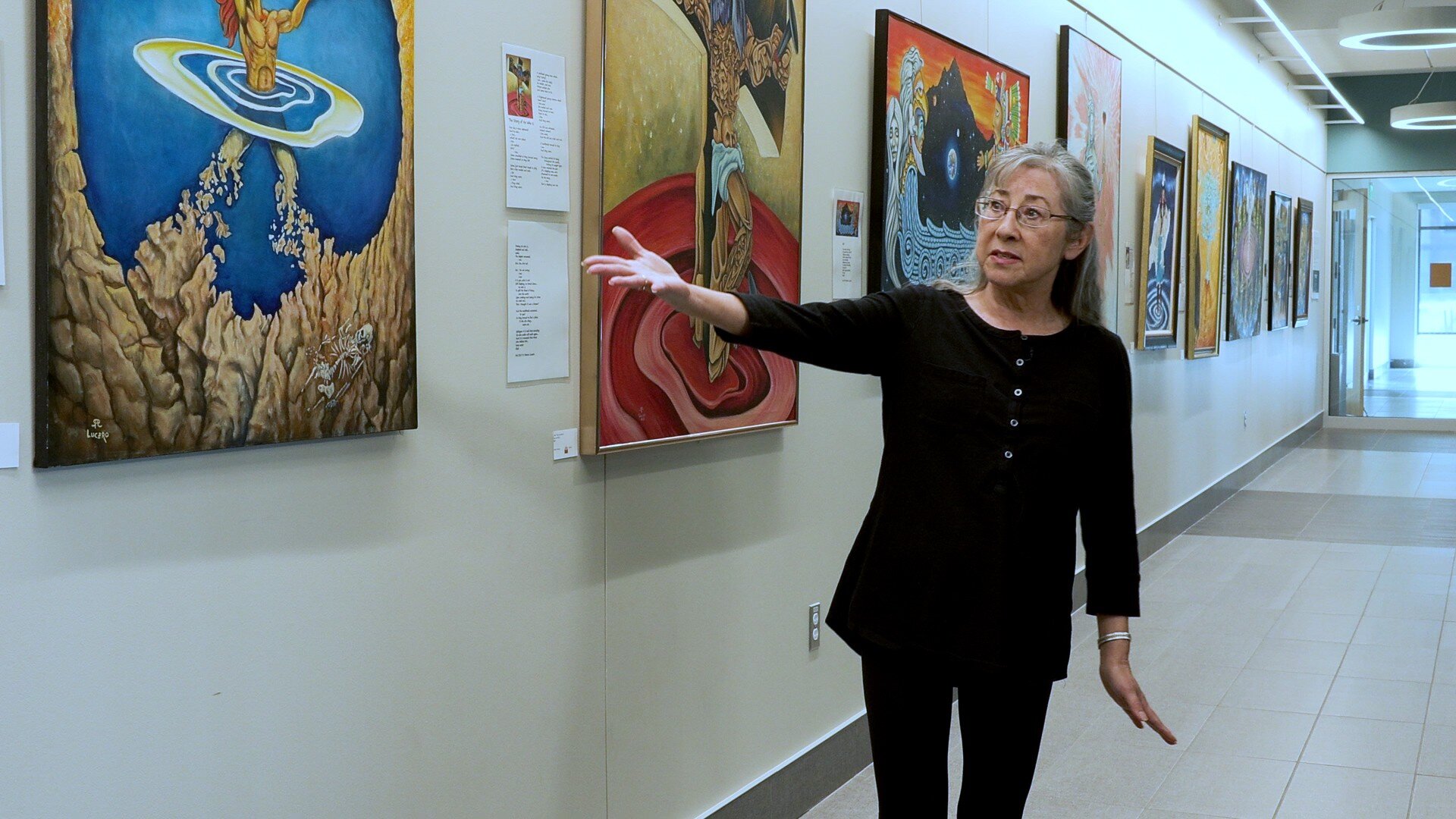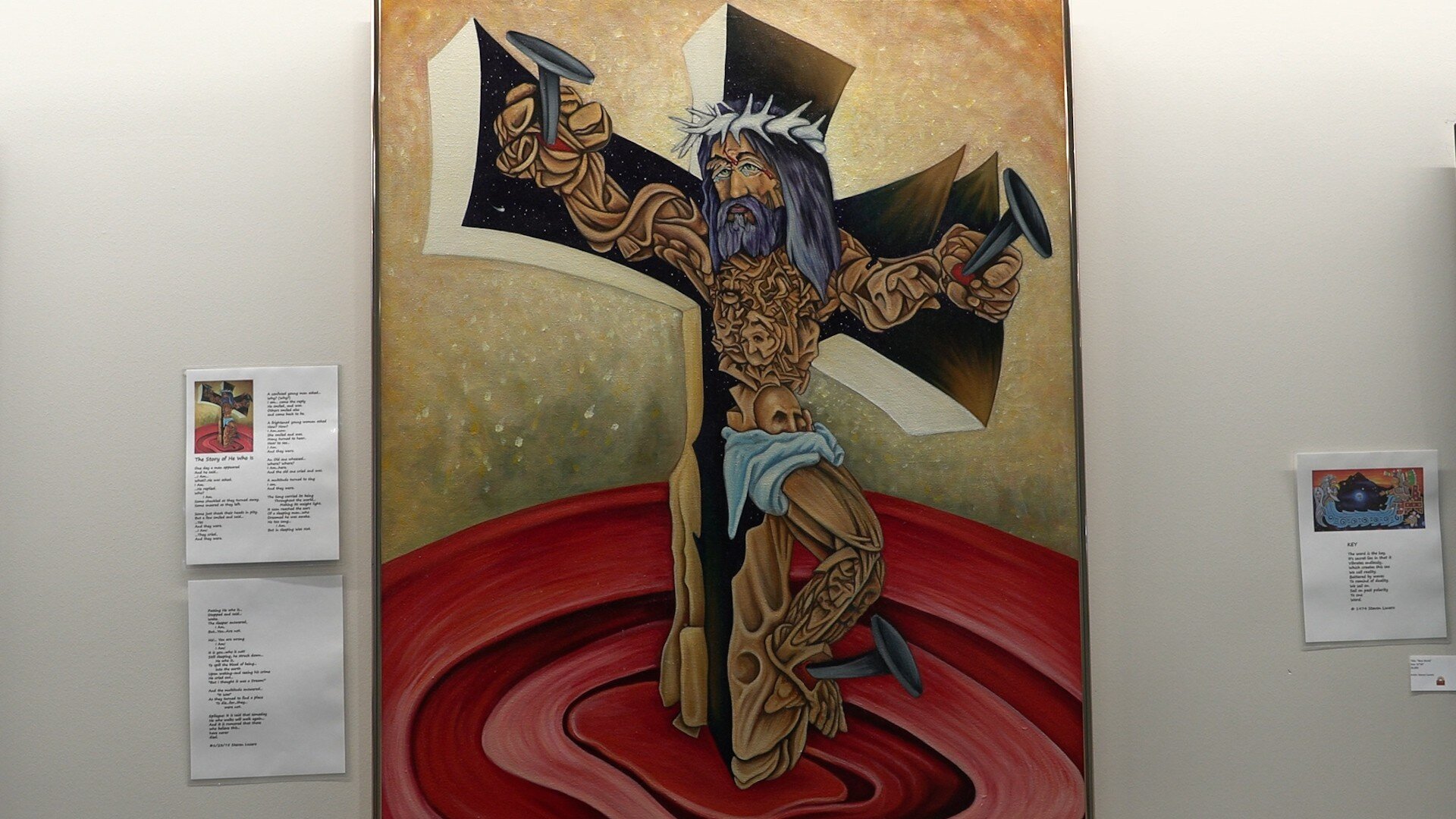The Constant Artist: CHAC co-founder Stevon Lucero's work lives on

NORTHGLENN, Colo. — In the Northglenn Arts center, about 15 miles north of Denver, a white hallway has transformed into a temple of "metarealism." It’s the first public exhibit at the center, which opened last fall, and it pays tribute to an artist who made an indelible mark on the Denver arts scene: Stevon Lucero.
One of the 10 founding members of the nonprofit Chicano Humanities and Arts Council, or CHAC, Stevon was a giant in the city's art world for decades. He helped create CHAC in 1978 after he and other Chicano artists in Denver felt their art wasn’t receiving the attention it deserved.
Stevon passed away Nov. 28 of last year at 72 years old.
In an interview with Rocky Mountain PBS, Stevon’s wife, Arlette — CHAC’s education director and a gifted artist in her own right — described her late husband as the Diego Rivera to her Frida Kahlo.
“He was the big artist, the constant artist,” Arlette said of Stevon. “The one who would paint every single day, the one who would go big. He had ideas constantly.”
She recalled instances of coming downstairs at 6 a.m. to discover that Stevon never came to bed. Instead, he had been up all night painting, sometimes working on as many as 11 canvases at once.
“So he would be flooded with ideas and so they all came at once," Arlette explained, "and he had to get them down before he lost them.”
At about a dozen paintings, each with an accompanying poem from Stevon, the exhibit in Northglenn is only a small sample of the artist’s oeuvre, but the work spans across many decades; some of the poems are from the early 1970s.
The exhibit, which is on display through the end of March, also provides an illuminating look at Stevon’s style over the years, particularly his penchant for working in metarealism, a style he developed in the early 70s. Arlette described metarealism as the “externalization of interior realities.”

“This is the stuff that was inside of him. It’s not surrealism so much,” Arlette said. “So he was able to take these ideas that were in his head — these images — and just put them on canvas.”
Looking into Stevon’s paintings can feel like looking into a dream. Much of his work includes cosmic and spiritual landscapes and other-worldly topography. Some of the work, though, is more clearly grounded in Stevon’s Catholic faith, like his paintings of the burning bush or the crucifixion of Jesus.

“I love the fact that we can show it to the world, or at least this part of the world,” Arlette said of Stevon’s exhibit, joking that it also cleared up space in her house. “And other people can see maybe what CHAC selfishly took for themselves. And now we can spread it out to different places.”
The early beginnings, and recent losses, of CHAC
Arlette met Stevon about a year or two after he co-founded CHAC, she said.
She had seen one of Stevon’s pieces in a newspaper — a painting called "Rainbow Boy" — and it made such an impact on her that she cut out the photo and asked her mom if she wanted to go and meet Stevon at an art show.

Arlette and her mother went to the show, hoping to speak to Stevon, but Arlette’s nerves and the crowd of people surrounding Stevon made that difficult.
“He was talking to [fellow CHAC co-founder] Carlos Sandoval and some other people, and not once did he have a break with people talking to him,” Arlette recalled.
Stevon was known for holding court at CHAC galleries, where it was common for him to have a rapt following of friends and fans eager to chat with him and seek advice, which he was happy to give.
That may be the most powerful part of Stevon’s legacy, Arlette said. “Your biggest impact is maybe not your sales — everybody loves your art, your prints go like crazy — but maybe it’s just when you talk and when people come to see you, and you give them your messages,” she recalled telling him.
Those messages date back decades. In 1980, Rocky Mountain PBS profiled Stevon and his fellow CHAC founding members Jerry Jaramillo and Fred Sanchez in a program called "Season Ticket,” which focused on arts and culture in Colorado.
Lucero guided the Rocky Mountain PBS news van around Denver, showing the crew various Chicano murals in the city, including one by Sanchez in the La Familia Rec Center gymnasium.
“I’ve always thought … fine art was a way of saying I am,” Stevon said in the video. “And it hit me that mural painting was a way of saying We are.”
Arlette and Stevon eventually met at a party, thanks to a mutual friend. Stevon told her that he remembered seeing her at that art show, but he admitted to Arlette that he had also been too shy to approach her.
The two were eventually married for 40 years. In that time, they saw a lot of change and experienced some difficult losses.
For years, CHAC was located at the corner of 8th Avenue and Santa Fe Drive in Denver’s historic Santa Fe Arts District. “That’s when [CHAC] just blossomed and became something spectacular,” Arlette said of the nonprofit’s longtime location.
But as the area became more popular, it became more expensive. CHAC moved from 8th and Santa Fe in 2018.
“We had to eventually move to 2nd and Santa Fe Drive because we got gentrified, priced out,” Arlette explained. “But that turned into a move that eventually … became something that we were very, very proud of.”
Rent at the new space, though, was still not cheap, and it didn’t have the benefit of foot traffic like the original location. When the COVID-19 pandemic hit in 2020, CHAC nearly went under.
The organization was able to survive with another move, but this time it had to leave Denver, which became too expensive. The nonprofit’s new home is at 1560 Teller St. in Lakewood, in the 40 West Arts District. Arlette said the community has been receptive and excited about the move, as well as the exhibits CHAC has organized in places like Northglenn.
“We found that when we moved north, there was a huge reception. Lots of Chicanos here, a lot of gente,” she said. “So yes, it’s been pretty enthusiastic. But people want us back in Denver.”
In addition to the move, the past year has been difficult because of the personal losses CHAC has experienced: About four months before Stevon passed away, Bob Luna, a multidisciplinary artist and teacher in Denver, died at the age of 65. On Dec. 27, 2021, CHAC artist and Sol Tribe owner Alicia Cardenas was one of the victims killed in a mass shooting.
“We are so honored to have her apart [sic] of the CHAC community and she forever lives in our hearts,” CHAC wrote after Cardenas’ death. “We don't have words for the pain we feel.”

“It’s always sad when you lose somebody who was important, especially an artist, musician — oh, we lost so many great musicians, too,” an emotional Arlette said. “But that’s what happens. We go on, we mentor the youth. And with the youth, they will become great artists and they will mentor the youth. And life goes on that way.”
Kyle Cooke is the digital media manager at Rocky Mountain PBS. You can reach him at kylecooke@rmpbs.org.
Jeremy Moore is a senior multimedia journalist at Rocky Mountain PBS. You can reach him at jeremymoore@rmpbs.org.
Brian Willie is the content production manager at Rocky Mountain PBS. You can reach him at brianwillie@rmpbs.org.

